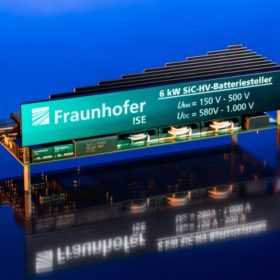
Kaco New Energy, STS Transformatoren Stockach, and Fraunhofer ISE have developed a new topology, management software, and transistors for hybrid inverters. Existing devices often suffer efficiency losses when power demand is low, as circuits and transistors are made to operate close to design specifications. The researchers claim their new tech could enable more battery use, based on simulation results.
Residential energy storage systems are riding a wave of popularity against a backdrop of new products offering integrated home power systems, the deployment of virtual power plants (VPPs), and the reduction and/or expiration of feed-in tariff (FIT) rates. Improving the efficiency of conversion steps from AC to DC, and vice versa, leads to lower losses from home batteries and less demand for grid power.
One of the main challenges involved in designing residential battery inverters is they will receive high power from rooftop arrays during midday peak-generation periods, thus fully charging within hours and then slowly discharging during overnight partial load demand.
Fraunhofer ISE, Siemens-owned inverter maker Kaco New Energy, and compatriot electronic engineering business STS-Spezial-Transformatoren Stockach launched the HyBaG project in 2017.
The project partners have developed a high-efficiency hybrid inverter that exhibits minimal losses. Inverters do not have the same efficiency levels throughout the entire power range that they can process. This is why the CEC and European weighted efficiencies are different for the same inverters. The CEC weighting method heavily focuses on efficiency at 70% power, whereas the European weighting method is biased toward 50% power.
The team considered several approaches to optimize the partial load behavior in a series of simulations. From this selection, the team chose the two best-performing simulations and launched prototypes for laboratory trials.
To improve efficiency throughout the power range, the researchers and business partners developed new hardware and software. On the hardware side, the team developed a compact and modular DC/DC converter that uses newly developed gallium nitride and silicon carbide transistors instead of industry-standard insulated-gate bipolar transistors. The resulting transistor bridge circuits allow increasing chopping frequency, which subsequently leads to lower switching losses.
Switching topology was developed so that it can accommodate partial loads more efficiently. The team used a three-phase synchronous converter for the DC/DC conversion. In this particular setup, the device could selectively switch on and off converter bridges to suit the specific load spectrum (one-third, two-thirds, full load).
At lower voltages, it was also possible to move into a variable switching frequency mode to always achieve the most moderate switching losses, known as “boundary conduction mode”. Alternatively, the team also examined the effects of a pulsating “burst-mode” at which the converter operates with just one phase and only 10% of the time.
“This can significantly increase the partial load efficiency, as it reduces the triggering and no-load losses that strongly influence the efficiency in the partial load range,” explains Cornelius Armbruster, project manager at Fraunhofer ISE.
The researchers say that it is advisable to alternate between the phases to achieve an even thermal profile of the three phases if only one phase is active at a time. Depending on the load spectrum, different modulation approaches proved most effective. Therefore, the project also included developing inverter management software, which optimizes via the modulation approaches according to pre-set load profiles.
Already it is possible to manufacturer silicon carbide-based components for residential storage systems at cost parity with other products. However, Fraunhofer ISE said that only a few manufacturers have started to optimize how systems react to partial loads. There are significant differences in how the different solutions react to partial load ranges.
“A major factor influencing the differences between the systems available on the market is the losses in the partial load range,” said Leonhard Probst, who is responsible for optimizing the battery charger in the project.
Simulations performed as part of the HyBag project showed that using a hybrid inverter with the hardware and software optimizations, as suggested by Fraunhofer and its partners, will save between €150 to €250 per year. As the saving comes from less demand for grid electricity and the research has been carried out in Germany, these figures are subject to Germany’s end-consumer electricity prices of around €0.28/kWh.
Lắp đặt điện mặt trời Khải Minh Tech
https://ift.tt/2X7bF6x
0906633505
info.khaiminhtech@gmail.com
80/39 Trần Quang Diệu, Phường 14, Quận 3
Lắp đặt điện mặt trời Khải Minh Tech
https://ift.tt/2ZH4TRU
Không có nhận xét nào:
Đăng nhận xét